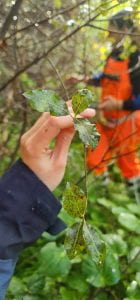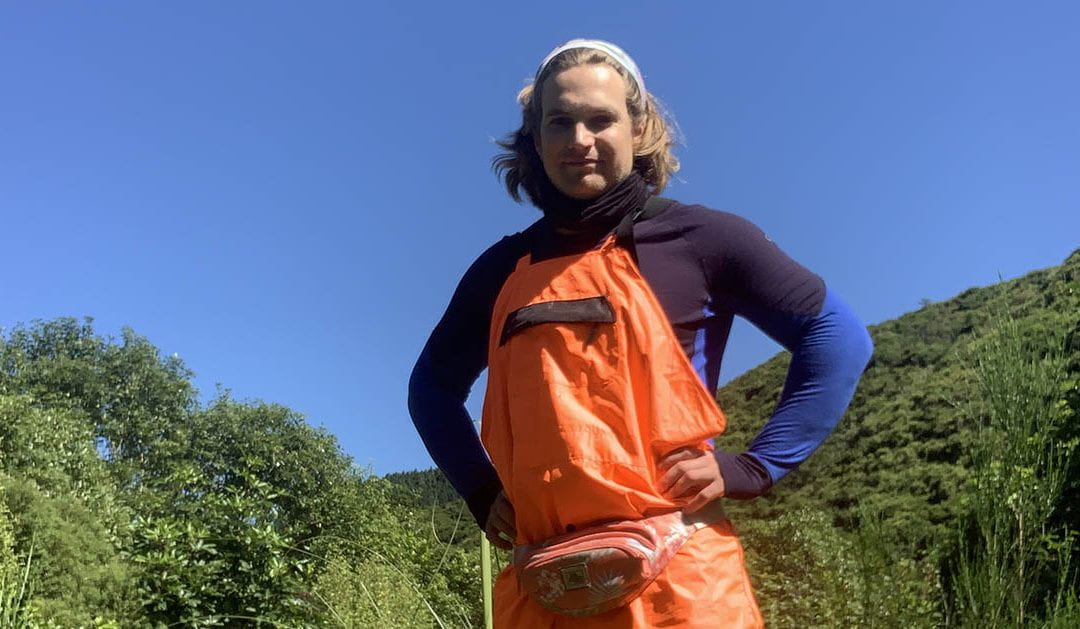7 December 2023
After his recent fieldwork, Henry Morse had almost 9,000 photos of plants on his phone.
Henry has been collecting data on how ecological restoration sites have been regenerating over time, to contribute to his PhD in landscape ecology and ecological restoration. He recently received seed funding from Te Pūnaha Matatini to employ two research assistants to assist with his fieldwork.
Ecological restoration aims to recreate, initiate or accelerate the recovery of an ecosystem that has been disturbed. The sites that Henry has been researching are diverse. They are of different ages, different sizes and different locations. Some are surrounded by urban landscapes, some by suburbs, and others by farmland.
Along with his research assistants Paul Bell-Butler and Faustine Cabanne, Henry completed vegetation surveys at sites across the lower North Island of Aotearoa New Zealand, using transects. Transects are straight lines that cut through a landscape so that standardised measurements can be made, tracked over time, and compared to other areas. This will give him a full census of the seedlings, saplings and older trees at each site, and allow him to assess whether regeneration is processing well or being stunted.
Each site took around a day to survey, and half a day afterwards to process all the data — logging huge numbers of plant identifications and measurements, and turning those thousands of photos into usable data.

Image: One of the thousands of plant identification photos taken by Henry and his research assistants.
At the moment, ecological restoration in Aotearoa is largely driven by motivated individuals. “There are a lot of individual landholders that are interested in ecological restoration,” says Henry. “Some have land that is too steep for crops, or so boggy that they lose stock in it. Restoring degrading hillslopes can prevent further loss of that area, and restoring a bit of wetland on a farm can save the cost of having to pay for losing stock each year.”
“Other people simply have a passion for restoration.”
For ecological restoration to have real benefit, it needs to move beyond these farm-scale projects run by individuals to broader landscape-scale projects. Henry’s overall PhD project is looking at what species to plant, where to plant, and why to plant for landscape-scale restoration. In the first chapter of his thesis, he looks at species distribution models under climate change futures, to get an idea if what we’re planting in restoration projects makes sense for the long term.
The data from this fieldwork will inform the second chapter on how restoration sites are recovering, based on their place in the landscape. “Regeneration sites within a certain proximinity of a seed source might show good diversity and abundance,” explains Henry. “So they might need less effort than another site.”
This analysis will be used to strategise restoration on a landscape-scale. Planting is labour-intensive and expensive, so this research will be useful to prioritise where to plant, and what can be left to regenerate on its own. “Natural regeneration is probably going to be the primary powerhouse behind getting regeneration going on the landscape scale,” says Henry.
In the final chapter of his thesis, Henry will explore different landscape-scale restoration scenarios. “If we were to restore five metres alongside every major waterway, what would the impact on the ecosystem be?” asks Henry.
Henry is originally from Los Angeles. Once he has completed his PhD, he wants to continue working in the Aotearoa research system. “The ecological research that’s happening here is amazing,” he says.
“The cutting edge of where ecology is going now is being led by mātauranga Māori. Even though it’s not what I’m working on, just being in the proximity of that feels awesome.”
And if there is a restoration site or group near you, Henry encourages you to get involved. “They can really use the support, and it does so much for your mental health.”
“Or just simply walk off the trail,” says Henry. “Wander around a little bit and get a feel for your local ngahere. It’s awesome.”

